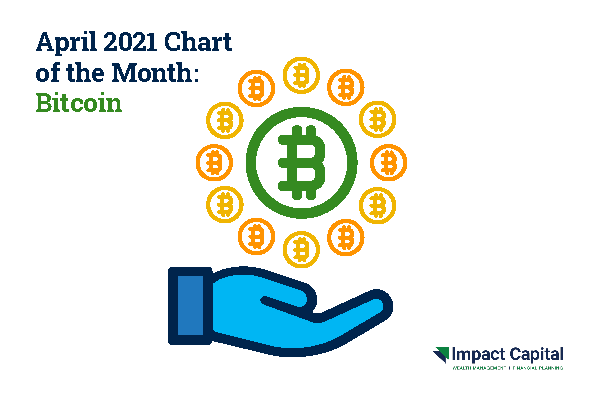
For everyone living in the 21st century, it is clear how the advent of new technologies over the last three decades has shaped various aspects of our lives and the way we do business. This includes the technology that has shaped the way we invest, which is why this edition of our Chart of the Month focuses on cryptocurrency – specifically, a cryptocurrency you may have heard of called Bitcoin.
What is Bitcoin?
Bitcoin is a decentralized digital currency that you can buy, sell, and exchange directly, without an intermediary. Each and every Bitcoin transaction that’s ever been made is saved on a public ledger—called the blockchain—accessible to everyone. Bitcoin isn’t backed by any government or institution, so there is nothing to guarantee its value. The supply of Bitcoin is limited to 21 million coins, which is why many people expect the price to rise over time, although it seems silly to pay for goods and services with an asset expected to rise in value over time. The term “cryptocurrency” is a bit of a misnomer. A currency needs to act as a medium of exchange and a store of value, so it is tough for Bitcoin to be a store of value when the price can drop 10% in a single day. This is why you don’t see items priced in terms of Bitcoins; it has proven too volatile to be a currency. Instead, we view it has a purely speculative investment.
Bitcoin as an Investment
I don’t know how the price of Bitcoin will perform in the future, and there is no way that anyone will know. Unlike stocks or bonds, there are no underlying company earnings to analyze or product to evaluate. There is no income or dividends to be had from owning Bitcoin, yet people are buying it simply because they think the value will go up. How has that worked out for them so far? Incredibly well, but it’s been a bumpy ride.
Bitcoin started trading on Coinbase—a cryptocurrency exchange platform—in late 2014 and skyrocketed in value by 5,000% since its debut until December 2017. It went from $300 to $19,891 during that time, but it dropped to $3,128—a stark 84% decrease—the following year. From there, it shot up by 87% in 2019, but then fell by 47% during the COVID-19 sell-off period. Since then, its value has risen by 930% to $53,350 as of April 22. As a frame of reference, the green line in the chart above is the S&P 500, which is up a paltry 102% over the same time frame.
Bitcoin, like any investment, is subject to investor sentiment. If people are scared, they are going to sell (and vice versa). Why else would a cryptocurrency’s value decrease during a pandemic? During its short history, Bitcoin seems to go up when stocks go up and down when stocks go down, but the degree to which it has yo-yoed in market value has just been much more dramatic than the moves in stocks.
The Risks of Investing in Bitcoin
The only reason this article was written is because of Bitcoin’s appreciation to date, and it’s safe to say that it is the only reason you’re reading, too. While the rise may get our attention, experienced investors know it is just as important to understand the risk of an investment. In the case of Bitcoin, we’ve already seen the risk – its value dropped by 84% back in 2018. Worse, the previous Bitcoin losses coincided with losses in stocks, so there hasn’t been any diversification benefit at those times. It also means that whatever risks affect stocks could also affect Bitcoin. This makes sense from a liquidity standpoint; if investors need to raise cash, they will do it from all sources.
Be Humble
With that knowledge in hand, you would invest only what you can afford to lose. Even if you are excited about the prospects of Bitcoin, be aware that it is easy to get caught up in the hype, so don’t put more than 10% of your portfolio in Bitcoin.
STAY IN THE LOOP

